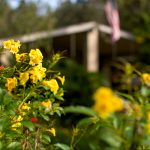Don’t waste water and time trying to rescue rescuegrass that’s fading fast and not meant to last.
It’s official: rescuegrass has started going to seed. Although it looks like lush turf grass pumped up by winter rains, it’s actually a winter weed. It and other winter weeds are now nearing the end of their short lifespans, turning yellow or brown and shedding lots of seedheads.
Rescuegrass is a shallow-rooted cool-season grass weed, widely dispersed in lawns and Texas pastures. It lives fast in winter, dies young in spring and grows back from seed every year. It’s easily distinguished from winter rye by its flat oat-like seedheads. With enough winter precipitation it may be by far the greenest grass of the year in south-central Texas, but it only lasts until April. With summer approaching and days warming up, rescuegrass is starting to quickly yellow.
Sudden stubble may seem alarming, but don’t be fooled into pampering it to revive it. Like other cool-season weeds, it’s just finishing up and going to seed. Because its growing season barely overlaps with warm-season Bermuda grass, St. Augustine and zoysia, rescuegrass is exiting stage left just as your summer turf is entering.
Look closely and you’ll notice your summer turf — growing in earnest now — is already starting to grow underneath it.
If you need quick relief from the seedy appearance of withering rescuegrass, mowing it is all you need to do at this point. (In mulched flowerbeds, it can be easily pulled.)
Here’s a few common questions that arise when you spot your winter grass competing with warm temperatures.
Why shouldn’t I water rescuegrass?
Many homeowners are so horrified by the seedy appearance of withering rescuegrass that they start watering heavily in April and May to bring it back. But watering rescuegrass is a waste of water because it’ll be completely replaced by warm-season grasses like Bermuda grass, St. Augustine, and zoysia — which haven’t yet needed irrigation this year.
With the Edwards Aquifer still historically low and Stage 2 restrictions continuing for the foreseeable future, it’s important to hold off turning on irrigation for a few more weeks. (Visit GardenStyleSA.com for current watering advice and the latest watering recommendations.)
How can I tell if my dying grass is just rescuegrass?
One of the easiest clues is its behavior, growing lushly during the wrong season (winter) and suffering just as the temperatures warm up.
The flattened spikelet seeds are also distinctive, with four to nine layers each. In addition, the leaf sheaths are noticeably “hairy.” (The upper surface of leaf blades may be fuzzy as well.) Since they’re so shallow-rooted, clumps pull out easily from the ground.
Will re-sodding my yard get rid of it?
Re-sodding isn’t the best solution due to the ongoing drought, and especially since for six months out of the year, rescuegrass is the greenest grass around! A better idea is to just keep mowing and wait for summer turf to return.
Even better: Add mulch, WaterSaver plants or outdoor living areas to your landscape to lessen the area dedicated to lawn.
Should I spray it with herbicide?
It’s too late. As I mentioned before, rescuegrass is already at the end of its winter growing season. Herbicide applied now can cause lasting damage to your summer turf.
The only herbicide semi-effective for rescuegrass might be a pre-emergent granular application to keep winter seedlings from germinating in the first place, but only if applied around Labor Day or early September. The downside: it will also suppress wildflowers and other beneficial plants.
The best and simplest solution is to just keep mowing. Rescuegrass will fade out over the next few weeks and once your summer turf returns you may never know the difference. For now, your mower is the most effective way to send it on its way and tidy up.



